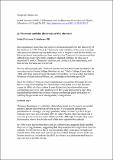Files in this item
J J Thomson and the Discovery of the Electron
Item metadata
| dc.contributor.author | Falconer, Isobel Jessie | |
| dc.date.accessioned | 2014-07-09T14:31:03Z | |
| dc.date.available | 2014-07-09T14:31:03Z | |
| dc.date.issued | 1999 | |
| dc.identifier | 130803202 | |
| dc.identifier | 31251039-cc0c-4d97-8dd6-b2b178b0ae6b | |
| dc.identifier | 78650567591 | |
| dc.identifier.citation | Falconer , I J 1999 , ' J J Thomson and the Discovery of the Electron ' , Physics Education , vol. 32 , pp. 226-231 . https://doi.org/10.1088/0031-9120/32/4/015 | en |
| dc.identifier.issn | 0031-9120 | |
| dc.identifier.other | ORCID: /0000-0002-7076-9136/work/46761197 | |
| dc.identifier.uri | https://hdl.handle.net/10023/4991 | |
| dc.description.abstract | One experiment, more than any other, is often associated with the `discovery of the electron' in 1897. This is J J Thomson's determination of the mass to charge ratio (m/e) of cathode rays by deflecting them in magnetic and electric fields. Yet this experiment was performed two months after Thomson first announced that cathode rays were very small, negatively charged particles. So why was it important? I look at Thomson's route to, and conduct of, the experiment, and then at how his ideas were received. | |
| dc.format.extent | 6 | |
| dc.format.extent | 115535 | |
| dc.language.iso | eng | |
| dc.relation.ispartof | Physics Education | en |
| dc.subject | Electron | en |
| dc.subject | History of physics | en |
| dc.subject | History of science | en |
| dc.subject | Q Science | en |
| dc.subject | History and Philosophy of Science | en |
| dc.subject.lcc | Q | en |
| dc.title | J J Thomson and the Discovery of the Electron | en |
| dc.type | Journal article | en |
| dc.contributor.institution | University of St Andrews. School of Mathematics and Statistics | en |
| dc.identifier.doi | 10.1088/0031-9120/32/4/015 | |
| dc.description.status | Peer reviewed | en |
| dc.identifier.url | http://iopscience.iop.org/0031-9120/32/4/015 | en |
This item appears in the following Collection(s)
Items in the St Andrews Research Repository are protected by copyright, with all rights reserved, unless otherwise indicated.

